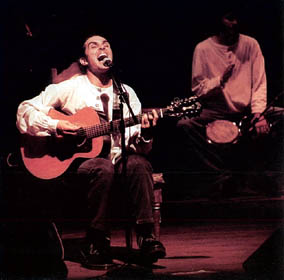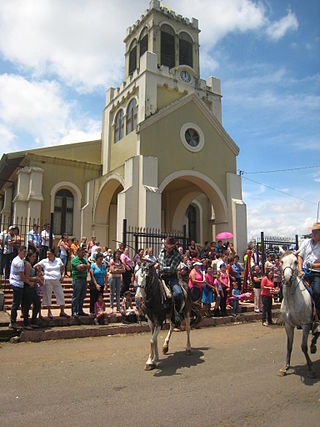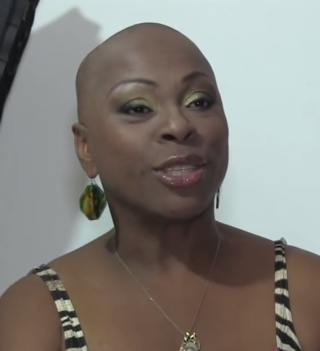Related Research Articles

San José is the capital and largest city of Costa Rica, and the capital of the province of the same name. It is in the center of the country, in the mid-west of the Central Valley, within San José Canton. San José is Costa Rica's seat of national government, focal point of political and economic activity, and major transportation hub. San José Canton's population was 288,054 in 2011, and San José's municipal land area is 44.2 square kilometers, with an estimated 333,980 residents in 2015. Together with several other cantons of the central valley, including Alajuela, Heredia and Cartago, it forms the country's Greater Metropolitan Area, with an estimated population of over 2 million in 2017. The city is named in honor of Joseph of Nazareth.

José Capmany was a Costa Rican songwriter and guitarist. Along with Enrique Ramírez, he was a founder of the band "Café con Leche", a popular rock band in Costa Rica in the late 1980s. His latest release "Canciones Cotidianas" included a compilation of his work. Songs like "El Barco", "La Historia Salvaje". "La Modelo" and "Mamá y Papá" are considered folk rock music in Costa Rica. He died in a car accident on October 13, 2001.

Rail transport in Costa Rica is primarily under the stewardship of Incofer, an autonomous institution of the state. Incofer owns the national railway infrastructure and operates virtually all freight and passenger services, which consist primarily of commuter trains through the highly populated Central Valley. The whole Incofer network is 1,067 mm narrow gauge, although there are several small tourist railways of other gauges.

Santa Bárbara is a canton in the Heredia province of Costa Rica. The head city is in Santa Bárbara district.

Gonzalo Morales Sáurez was a Costa Rican painter. He studied in The San Fernando Academy in Madrid, Spain from 1970 to 1974. He is best known for his hyper-realistic works, and has exhibited his art in many museums and art galleries in Europe and the Americas.

Montes de Oca is a canton in the San José province of Costa Rica. The head city of the canton is San Pedro.

Naranjo is a canton in the Alajuela province of Costa Rica. The head city is located in the homonymous Naranjo district.

Orotina is a canton in the Alajuela province of Costa Rica. The head city of the canton is also called Orotina.

Dota is a canton in the San José province of Costa Rica. The head city of the canton is Santa María.
Puntarenas is a canton in the Puntarenas province of Costa Rica. The head city is Puntarenas.
Guillermo Vargas Jiménez, also known as Habacuc, is an artist best known for the controversy caused when he exhibited an emaciated dog in a gallery in Nicaragua in 2007.

San Pedro, is one of the six districts of the Santa Bárbara canton, in the Heredia province of Costa Rica. It is located 2.5 kilometers (1.6 mi) west of Santa Bárbara and is officially a part of the province of Heredia. The elevation is approximately 1,080 meters (3,540 ft) above sea-level.
Cecilia Paredes is a Peruvian-born multimedia artist residing in Philadelphia. Her primary themes include the power of nature, femininity, and migration, which have been subjects of many of her shows. She frequently utilizes natural elements, often recycled waste materials and primarily organic ones, in her installations. One of her best-known works is "Paisajes" in which she camouflages herself and uses her own figure as a canvas for body painting.

Guadalupe Urbina is a Costa Rican singer-songwriter, poet, and activist. Urbina is a folk musician whose compositions reflect the oral tradition of Guanacaste, her birthplace. She has performed in both Europe and the United States and has won various awards for her work domestically and internationally.

Sara Casal de Quirós was a Costa Rican teacher, writer and community worker. She was a pioneer of the women's rights movement in Costa Rica and wrote the first book defending women's rights in the country.

The COVID-19 pandemic in Costa Rica was a part of the ongoing worldwide pandemic of coronavirus disease 2019 caused by severe acute respiratory syndrome coronavirus 2. The virus was confirmed to have spread to Costa Rica on 6 March 2020, after a 49-year-old woman tourist from New York, United States, tested positive for the virus.

Thelma Darkings Bucknam is a Costa Rican actress and television presenter. She is known for hosting the Costa Rican talk show programs Conectados and previously Entre nos. Her film credits include Noi siamo angeli (1997), Caribe (2004), and El último comandante (2010).
Adrián Arguedas Ruano is a Costa Rican contemporary artist who works in painting, printmaking and sculpture.
The Conservatorio de Castella is an arts institute located on the Pan American Highway, in Heredia, Costa Rica. In 2016 the school was honored by a Declaratoria de Benemérito de la Patria,, which recognized the historical distinction of the school, and also provided for campuses of the school to be established in each of the seven provinces in Costa Rica.
Tatiana Muñoz Brenes is a Costa Rican art curator specializing in queer and transfeminist art. She graduated in Art History and Psychology from the University of Costa Rica, where she works as a researcher and teacher. She is a member of the Board of Directors of ICOM Costa Rica. She is a winner of the Fulbright scholarship, she is pursuing a master's degree in Museum Studies from the New York University.
References
- ↑ Tribunal Supremo de Elecciones. "Consulta Nacionales por Nombre". www.consulta.tse.go.cr. Retrieved 2020-08-27.
- ↑ PREMECHI. "Proyecto de Recuperación de la Memoria Histórica de la Migración China en Costa Rica". Costa Rica: Instituto Confucio. Archived from the original on 7 June 2020. Retrieved 1 April 2020.
- ↑ "Man Yu" (in Spanish). Spain: Artelista. 2020. Retrieved 4 April 2020.
- 1 2 3 4 5 6 7 8 Arteinformado (2020). "Man Yu". Spain: Arteinformado. Retrieved 5 April 2020.
- 1 2 3 Calderón, Yecid (3 September 2019). "Man Yu: el cuerpo como traje". Hypermedia Magazine (in Spanish). USA. Retrieved 4 April 2020.
- 1 2 Costa Rica Ni Hao (13 August 2019). "#NoticiasUniversidad hoy con la artista plástica Man Yu" (in Spanish). Costa Rica: Radio Universidad. Retrieved 4 April 2020– via facebook.
- ↑ "Entrevista con Man Yu, artista china-costarricense que enlaza las dos culturas". China: China Radio International. 1 November 2017.
- ↑ Estrada, Damián (17 June 2019). "Man Yu: De Costa Rica a China con su Traje Humano". China Today (in Spanish). China. Retrieved 4 April 2020.
- 1 2 Redacción Revista Íkaro (25 November 2017). "Man Yu, pintora costarricense más destacada del realismo contemporáneo" (in Spanish). Costa Rica: Revista Íkaro. Retrieved 4 April 2020.
- 1 2 3 CR Ni Hao (6 October 2015). "Man Yu en Costa Rica Ni Hao" (in Spanish). Radio Universidad. Retrieved 4 April 2020.
- 1 2 Pistas Sonoras (8 April 2017). "Man Yu en Pistas Sonoras" (in Spanish). Costa Rica: Radio Universidad. Retrieved 4 April 2020.
- 1 2 Lam, Iris (2016). "Galeristas, coleccionistas y pintores: Diseño de una estrategia comercial para pintores costarricenses emergentes del 2005 al 2015". Trabajo Final de Graduación Para la Maestría en Gerencia Estratégica de la Universidad Estatal a Distancia.
- 1 2 3 Martínez, Rodrigo (9 May 2018). "Man Yu: 'La estética sin consciencia y coherencia, no es arte'" (in Spanish). Costa Rica: Instituto Confucio. Retrieved 4 April 2020.
- ↑ Fung Li, Man Yu (2020). "Tizas" (in Spanish). Costa Rica.
- ↑ Redacción El País (6 April 2015). "Artista costarricense Man Yu en el Club Unión". El País (in Spanish). Costa Rica. Retrieved 4 April 2020.
- ↑ Instituto Confucio (22 October 2015). "Exposición artística: Mujeres del Oriente, por Man Yu" (in Spanish). Costa Rica: Instituto Confucio. Retrieved 4 April 2020.
- ↑ Contexto 360. "Contexto 360: Programa del 06 de noviembre del 2018" (in Spanish). Costa Rica: Cadena Radial Costarricense. Retrieved 4 April 2020.
- 1 2 Fung Li, Man Yu. "Resumen fotográfico del Circuito Traje Humano" (in Spanish). Costa Rica: Issuu. Retrieved 4 April 2020.
- ↑ Fernández, Ana Beatriz (6 November 2018). "Los hábitos que hacen a Man Yu" (in Spanish). Costa Rica: Semanario Universidad. Retrieved 4 April 2020.
- ↑ Durán, Juan (28 January 2019). "Traje Humano: Cartago nos muestra su piel" (in Spanish). Costa Rica: Revista Traffic. Retrieved 4 April 2020.
- ↑ González, Adison (1 November 2018). "Artista de los cuerpos desnudos expondrá sus obras" (in Spanish). Costa Rica: AM Prensa. Retrieved 4 April 2020.
- ↑ San José Volando (24 March 2019). "La artista Man Yu desnuda a Cartago con Traje Humano". San José Volando (in Spanish). Costa Rica. Retrieved 4 April 2020.
- ↑ San José Volando (31 March 2019). "Los Trajines que vivimos toman vida en Barrio Escalante". San José Volando (in Spanish). Costa Rica. Retrieved 3 April 2020.
- ↑ González, Melissa (6 June 2019). "Artista tica expondrá sus obras en China" (in Spanish). Costa Rica: La República. Retrieved 3 April 2020.
- ↑ Mandel, Claudia (18 July 2019). "Traje Humano por Man Yu" (in Spanish). Costa Rica: Museo de las Mujeres. Retrieved 3 April 2020.
- ↑ "Desnudo colectivo de gente causó gran atención en San José". Redacción El Guardián (in Spanish). Costa Rica. 31 August 2019. Retrieved 4 April 2020.
- ↑ CR Hoy Redacción (31 August 2019). "¿Qué hacían todas estas personas desnudas en San José?". CR Hoy (in Spanish). Costa Rica. Retrieved 4 April 2020.
- 1 2 González, Melissa (3 September 2019). "Artista tica cerró exposición con colectivo al desnudo" (in Spanish). Costa Rica: La República. Retrieved 3 April 2020.
- ↑ Corrales, Eric (30 August 2019). "VIDEO: Más de 100 personas se desnudan en las inmediaciones de la antigua aduana" (in Spanish). Costa Rica: Teletica. Retrieved 4 April 2020.
- ↑ "El Circuito Traje Humano, anuncia un gran performance colectivo con más de 100 participantes para este 30 de agosto" (in Spanish). Costa Rica: Revista Íkaro. 27 August 2019. Retrieved 4 April 2020.
- ↑ Pelando el Ojo (2 September 2019). "Pelando el Ojo: Programa 02 de setiembre del 2019" (in Spanish). Costa Rica: Radio Monumental. Retrieved 4 April 2020.
- ↑ "Artistas ticos ganan premio al mejor cortometraje en festival internacional". San José Volando (in Spanish). Costa Rica. 19 September 2019. Retrieved 4 April 2020.
- ↑ "European International Film Festival". Russia. Retrieved 3 April 2020.
- ↑ Fonseca, Cristina (25 October 2018). "Man Yu la artista de los cuerpos al desnudo" (in Spanish). Costa Rica: El Guardián. Retrieved 4 April 2020.
- ↑ Villalobos, Natalia (13 September 2017). "Artista Man Yu representa a Costa Rica en la 7ma Beijing International Art Biennale". El País (in Spanish). Costa Rica. Retrieved 4 April 2020.
- ↑ "Embajada de Costa Rica en China". Noticias de la Embajada de Costa Rica en China. 20 June 2019. Retrieved 2020-02-05.
- ↑ Mesén, Roberto (1 August 2019). "Obra de artista Man Yu conmemorará relaciones diplomáticas entre Costa Rica y China" (in Spanish). Costa Rica: Rumbo Económico. Retrieved 4 April 2020.
- ↑ Redacción El Mundo (1 August 2019). "Artista Man Yu es seleccionada para conmemorar relaciones diplomáticas entre Costa Rica y China". El Mundo (in Spanish). Costa Rica. Retrieved 4 April 2020.